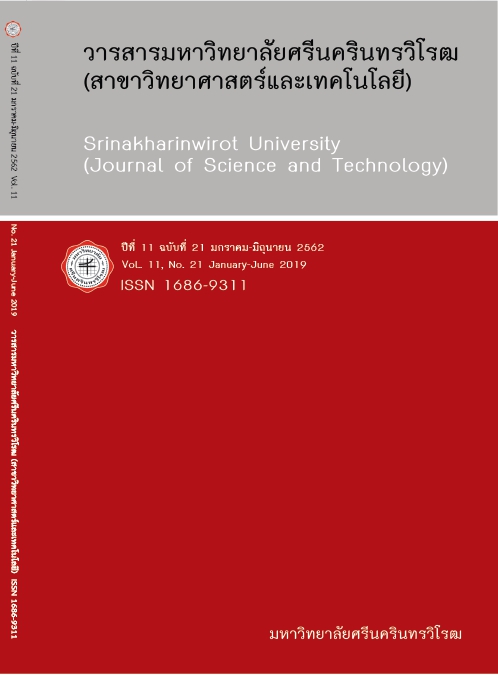ความสามารถในการรองรับกรดในอ่างเก็บน้ำเขื่อนวชิราลงกรณ จังหวัดกาญจนบุรี โดยการใช้ The First-Order Acidity Balance Model A CRITICAL LOAD FOR ACIDITY OF VAJIRALONGKORN RESERVOIR IN KANCHANABURI PROVINCE BY USING A FIRST-ORDER ACIDITY BALANCE MODEL
Keywords:
Critical Load Of Acidity, Sulfur and Nitrogen Deposition, The First-Order Acidity Balance (FAB) ModelAbstract
This study estimates the critical load (CL) of acidity for Vajiralongkorn reservoir, Kanchanaburi province by the first-order acidity balance (FAB) model, which bases its calculation on the steady state mass balance between sinks and sources of sulfur and nitrogen. The data required for calculation can be classified into two groups: direct and indirect data. Direct data is that which can be collected directly from sources of information. These include catchment area, forest in the catchment area, lake area and sulfur and nitrogen depositions. The indirect data are the estimated values, annual run off, sulfur and nitrogen uptakes, and base cation concentrations at a pre-industrial rate.
The results estimate of data used to calculate the critical load of acid, nitrogen uptake was 9,980 eq/ha/yr, annual runoff was 1.15 m/yr and annual averages of sulfur and nitrogen depositions were 121.96 and 85.09 eq/ha/yr, respectively. The deposition monitoring amount in Kanchanaburi was 4 times lower compared with Bangkok. Depending on the quality of input data, their sensitivity, and the complexity of the FAB model, a value for acid neutralizing capacity (ANC) limit of 20 μeq/liter was used to calculate CL. To ensure no damage to fish. The critical load of acidity (sulfur and nitrogen) in the Vajiralongkorn reservoir was 6.637 keq/ha/yr.
Downloads
References
[2] Pollution Control Department. (2015). Acid Precursors: Transboundary pollution. Retrieved April 4, 2015, from http://www.pcd.go.th/info_serv/air_aciddeposition.html
[3] Kowit Suwannahong. (2002). Study of Acid Deposition in the Western Region of Thailand. Dissertation, M.Sc. (Environmental Technology). Bangkok: Graduate School of King Mongkuts University of Technology Thonburi.
[4] Acid Deposition Monitoring Network in East Asia. (2015). Data Report on the Acid Deposition in the East Asian Region. Retrieved April 15, 2015, from http://www.eanet.asia
[5] Federal Environmental Agency. (1996). Manual on methodologies and criteria for mapping critical levels/loads and geographical areas where they are exceeded. n.p.
[6] Aherne, J; Posch, M; Dillon, P.J.; & Henriksen, A. (2004). Critical loads of acidity for surface waters in south-central Ontario, Canada: Regional applications of the first-order acidity balance (FAB) model. Water, Air, and Soil Pollution: Focus. 4: 25-36.
[7] Nakkares Sonsupap. (2007). Analysis on Distribution and Structure of Benthic Fauna Communities for Assessment of Aquatic Enrichment Status in Vajiralongkorn Reservoir and Srinakarin Reservoir. Dissertation, M.Sc. (Fisheries Science). Bangkok: Graduate School of Kasetsart University.
[8] Posch, M; Kämäri, J; Forsius, M; Henriksen, A; & Wilander, A. (1997). Exceedance of Critical Loads for Lakes in Finland, Norway, and Sweden: Reduction Requirements for Acidifying Nitrogen and Sulfur Deposition. Environmental Management. 21(2): 291-304.
[9] Henriksen, A. (1998). Application of the First-order acidity balance (FAB) model to Norwegian surface waters. Norwegian Institute for Water Research Oslo, Norway.
[10] Henriksen, A; Forsius, M; Kämäri, J; Posch, M; & Wilander, A. (1993). Exceedance of critical loads for lakes in Finland, Norway and Sweden: Reduction requirements for nitrogen and sulfur deposition. Acid Rain Research Report 32/1993, Norwegian Institute for Water Research, Oslo, Norway.
[11] C.E.W., Steinberg; R.F., Wright. (1992). Acidification of Freshwater Ecosystems Implications for the Future. n.p.
[12] Phanumard Ladpala; and Samreong Panuthai. (2006). Structure and Dynamics of Mixed Deciduous Forest at the Maeklong Watershed Research Station. Forest and Plant Conservation Reseach Office, Department of National Parks, Wildlife and Plant Conservation. Bangkok.
[13] Hall, J; Bull, K; Bradley, I; Curtis, C; Freer-Smith, P; Hornung, M; Howard, D; Langan, S; Loveland, P; Reynolds, B; Ullyett, J; & Warr, T. (1998). Status of UK critical loads and exceedances. Part 1: Critical loads and critical load maps. Report prepared under DETR/NERC Contract EPG1/3/116.
[14] Xuemei Ye; Jiming Hao; Lei Duan; & Zhongping Zhou. (2002). Acidification sensitivity and critical loads of acid deposition for surface waters in China. The Science of the Total Environment. 289: 189-203.
[15] ICP Modelling & mapping. (2015). Critical Loads for Aquatic Ecosystems. Retrieved April 1, 2015, from http://www.icpmapping.org/Mapping_Manual
[16] Henriksen, A; & Dillon, PJ. (2001). Critical load of acidity in south-central Ontario, Canada: I. Application of the Steady-State Water Chemistry (SSWC) model. Acid Rain Research Report 52/01, Norwegian Institute for Water Research, Oslo, Norway.
[17] Lien, L;, Raddum, GG; Fjellheim, A; & Henriksen, A. (1996). A critical limit for acid neutralizing capacity in Norwegian surface waters, based on new analyses of fish and invertebrate responses. The Science of the Total Environment. 177: 173-193.
[18] Dupont, J; Clair, T.A.; Gagnon, C; Jeffries, D.S.; Kahl, J.S.; Nelson, S.J.; & Peckenham, J.M. (2005). Estimation of Critical loads of acidity for lakes in northeastern United States and eastern Canada. Environmental Monitoring and Assessment. 109: 275-291.
[19] Lien, L; Henriksen, A; & Traaen, Tor S. (1995). Critical loads of acidity to surface waters: Svalbard. The Science of the Total Environment. 160/161: 703-713.
Downloads
Published
How to Cite
Issue
Section
License
Srinakharinwirot University Journal of Sciences and Technology is licensed Under a Creative Commons Attribution-NonCommercial-NoDerivs 4.0 International (CC-BY-NC-ND 4.0) License, Unless Otherwise Stated. Please Read Journal Policies Page for More Information on Open Access, Copyright and Permissions.



